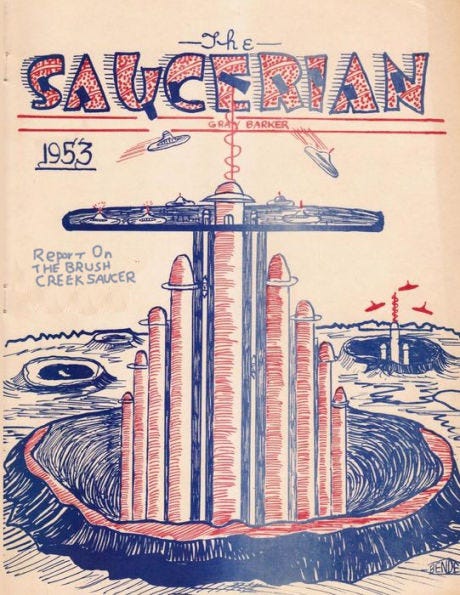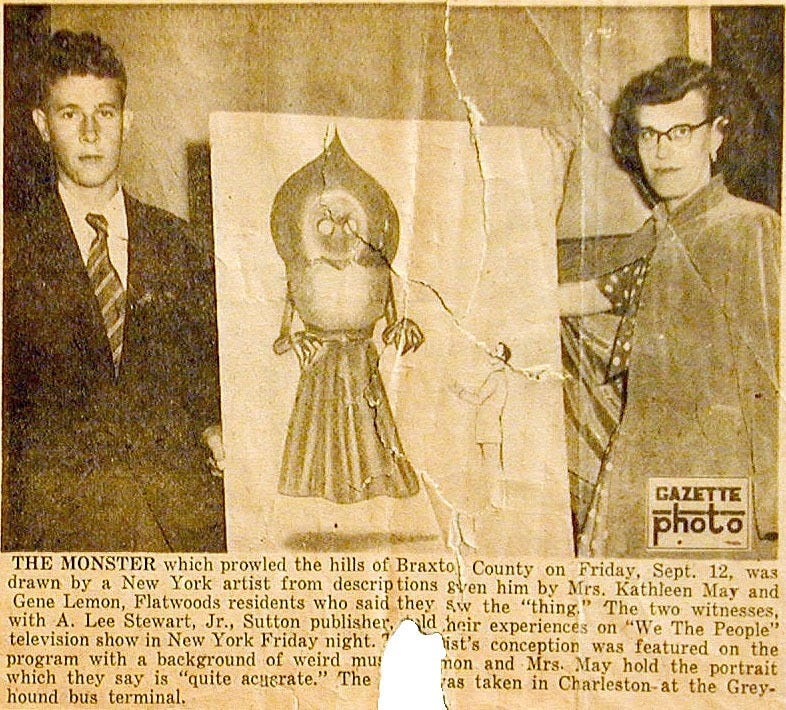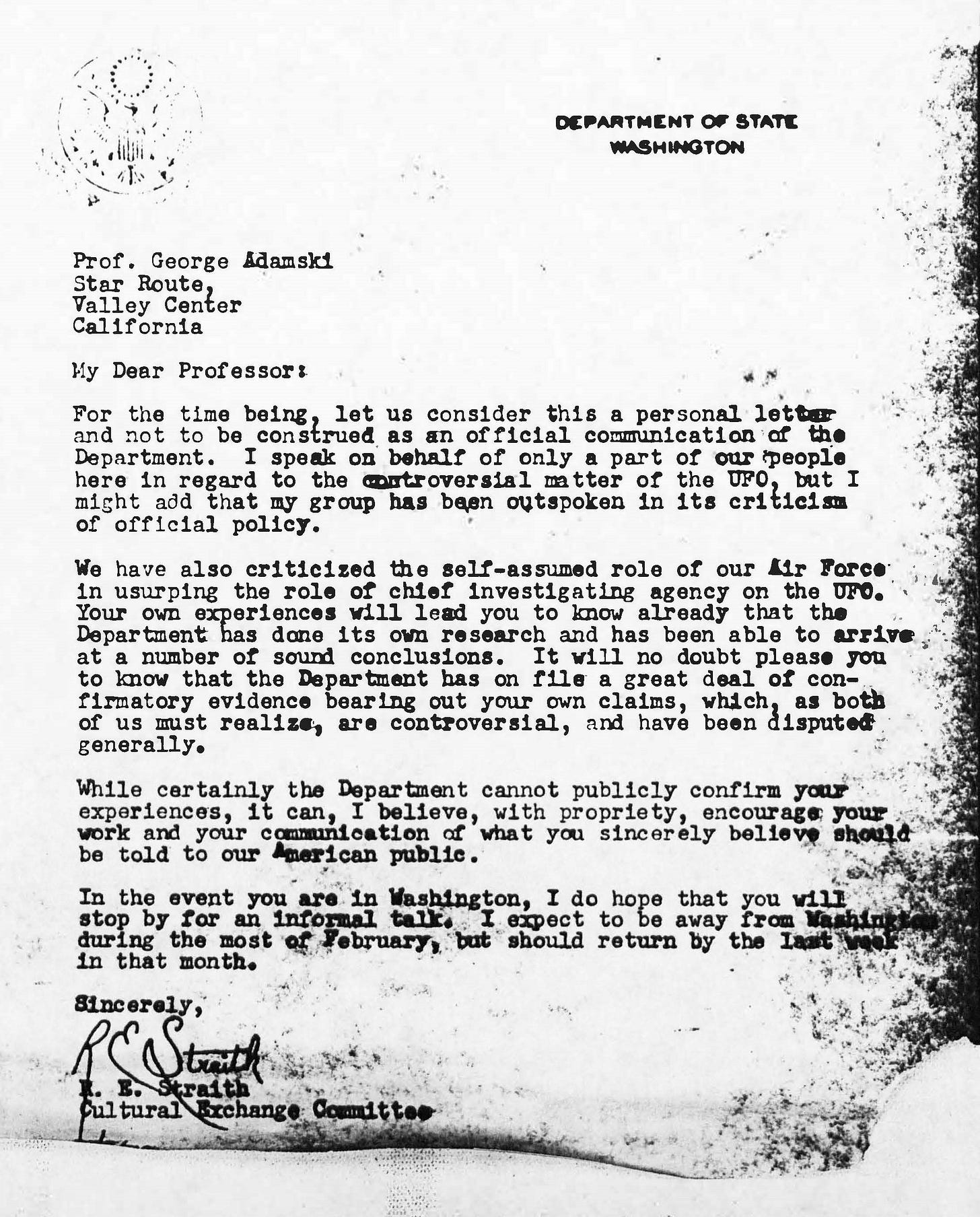Carnival Barker! A Review of "The Saucerian"
Bernie O. gives it a go and finds McKee's latest to be more entertaining than a man in black riding mothman up the ramp of a flying whatzit.
A review of The Saucerian: UFOs, Men In Black, and the Unbelievable Life of Gray Barker by Gabriel McKee, MIT Press, Cambridge Massachusetts, London, England 2025.
Gray Barker was a man of many disguises. Fraudster? Hoaxer? Teller of tall tales? Entertainer? Armchair investigator? Or, was he just an everyday Joe trying to make a buck off something he loved doing—that of playing the role of the grand trickster of Ufology? All aspects of Gray’s many different personas are explored in author Gabriel McKee’s scholarly work on a life well examined, The Saucerian.
The TikTok / YouTube generation may be asking right now: “Who the heck is Gray Barker?”
Way back in the dream time before the 24/7 news cycle of the internet, “Flying Saucer Buffs,” as we were called, got our UFO news from cheaply printed newsletters and photocopied fanzines. Barker was one of the many pioneers in creating such material and his entry into the mix was titled The Saucerian.
Most of these periodicals often took a more sensationalist approach to publishing information about Flying Saucers. They often stretched the limits of credulity. As readers of such fare, we learned about the Flatwoods Monster, the Kelly-Hopkinsville Goblins, inner earth civilizations peopled by surviving Atlanteans, and crashed spaceships. Most importantly, we learned about the sinister government cover-up of all unidentified aerial anomalies. I know. I subscribed to many of them at the time. What better use could there possibly be for all my after school job money?
Barker, along with his drinking buddy in hoaxing, James Moseley, created some of the more memorable run-arounds in Ufology. One of them being the notorious “Straith Letter” sent to the world famous contactee, George Adamski. The letter, written on official State Department stationary, claimed that the US government was “unofficially “endorsing Adamski’s wild claims of meeting space people and taking trips on Flying Saucers. Adamski quickly capitalized on the letter, promoting it to his many followers and the press. Gray’s prank had worked too well.
The ensuing controversy caused Barker to panic and destroy the typewriter he wrote the letter on. He then buried the remains of it in concrete. For a while after this prank, he lived in fear of being investigated and prosecuted by the Feds for the unauthorized use of the official letterhead.
Pairing this mischief with mysterious letters and late night crank phone calls to other researchers “Warning them off further investigation of Flying Saucers because they were too close to the truth,” made for good circulation-building fodder for The Saucerian.
Undoubtedly Gray Barker’s biggest and most enduring contribution to Ufology was the publication in 1956 of his first book, They Knew Too Much About Flying Saucers, which introduced the world to the Men In Black. Although the jury is still out on the reality of these infamous “UFO silencers,” they are deeply ingrained in our collective culture, extending well outside their origin in the ufological canon. In addition to his own publications, Barker also contributed many articles to Fate, Amazing Stories, Fantastic Universe, and Flying Saucers Magazine.
McKee’s book is not just about Barker’s hilarious saucer shenanigans, it also addresses his lifelong personal struggles. His trying to earn a decent living by booking and promoting movies for Drive-in theaters. His many business ventures and bankruptcies. And most critically, the recurring legal and emotional problems arising from questions about his sexuality in an era when acceptance was scarce.
To gain such insight into Baker’s life, author Gabriel McKee went to the depository of Barker’s many letters and files: the Clarksburg-Harrison Public Library in West Virginia—Barker’s home state. The Barker Collection consists of approximately 29 drawers of file folders, 300 books, 75 groups of magazines and photographs of Barker along with various saucer memorabilia. It’s truly an amazing resource for any student of early Ufology.
Be prepared to have plenty of 3M sticky notes handy when reading. McKee weaves copious citations throughout the chapters, prompting frequent trips to the notes section. The depth and detail of his research create the sense of a second book hidden within the first.
In short, The Saucerian is more than a biography, it’s an important historical document that accurately captures the nostalgia for a simpler and more innocent stage of Ufology.
This exceptional tome could turn out to be the UFO book of the year.
BERNIE O’CONNOR grew up in a haunted apartment building in New York City and was introduced to paranormal hi-jinks at a very early age. The Twilight Zone, along with a steady diet of black and white, Grade B, sci-fi movie reruns and a 1966 paperback edition of Frank Edward’s Flying Saucers-Serious Business set him on a life long skywatch for the one-eyed, one-horned, flyin' purple people eater. In one of his more fun adventures, he was the editor of Official UFO Magazine.
Reach him at: bernieolooksforufos@gmail.com
















